In general a file manager is a program that gives some kind of interface to the file system and that show in a graphical or textual way the files and directory, usually a file manager allow to do some standard operations such as delete, rename copy/paste and other typical operations that you can do on files.
Twin-panel file managers have obligatory connected panels where action in one panel results in a reaction in the second. So for example you could move a file from the first to the second panel, or copy it. In this roundup I‘ll show you some of the most used Twin-panel file manager available on Linux, sometimes they are also called Orthodox file managers or command-based file managers and in general they have three windows (two panels and one command line window).
Note: Konqueror supports multiple panels divided horizontally, vertically or both, but these panels do not act as twin panels by default (the user has to mark the panels he wants to act as twin-panels), so I’ll not put it in this article.
Gentoo
One of my favorite Distribution, but also the name of a twin-panel file manager.
Latest: 0.19.13 Released: 2012-03-18
Gentoo, is a GTK+ file manager. The current release series of gentoo is called 0.19.x. It is based on the 2.x series of the GTK+ toolkit.
Gentoo provides a two directory pane listing with sticky toggling of selections, A pile of operations you can do in or across directories, highly customizable file recognition, easy extension and generally gets out of the way of doing real work.
Some of Gentoo’s main features include:
- Reasonably small and fast (written in C).
- Support for most typical file operations (copy, move, rename, makedir etc.).
- Uses GIO, which means file system access is virtualized.
- Direct graphical configuration of most main features.
- A powerful file recognition system that allows you to configure how files of different types are listed (what colors and icons), and what happens when you double click them (start image viewers, music players, etc.).
- Includes more than 120 original pixmap icons.
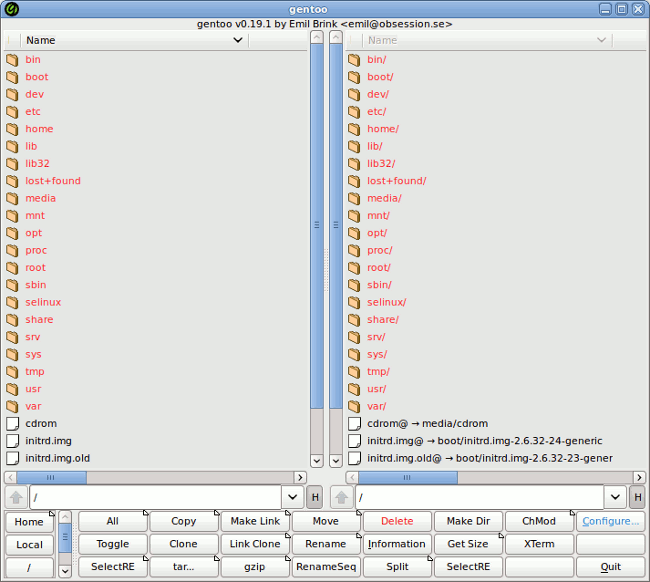
emelFM2
This is another twin-panel manager done with GTK+ 2, clean and simple.
The latest source-code release is: emelfm2-0.8.1.tar.bz2 (1073 kb) – Released 2012-04-20
The main window is divided into three parts. Two of those (side-by-side or top-to-bottom) show the contents of selected filesystem directories. The third pane, at the bottom of the window, shows the output of commands executed within the program. Those panes can be resized, and any one or two of them can be hidden and unhidden, on request. A built-in command-line, toolbar buttons or assigned keys can be used to initiate commands.
Some feature of this software are:
- Bookmarks and history lists
- An embedded Trashcan that saves all your deleted files
- Drag and Drop between the 2 panels
- Filters to display files/directory that matches a particular pattern
- An output box on the bottom to show the result of commands
NOTE: There is also emelFM a file manager that implements the two-pane design in a simple GTK+ interface.
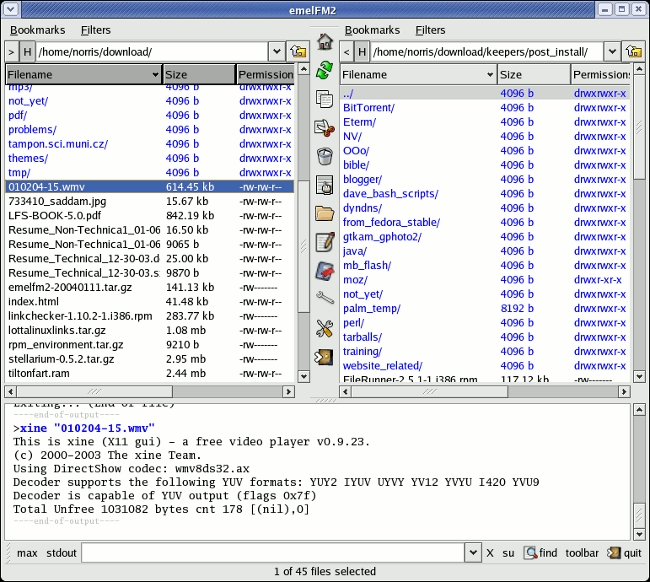
Krusader
As you can expect from the starting K Krusader is a file manager born for the KDE Desktop Environment.
Last Stable is the version 2.0.0 – Release date: 2009-Apr-11, a beta release is updated regularly.
Krusader has a lot of options compared to many of the other softwares in this category, it can connect to a remote server via SFTP or FTP and compare local and remote files, or do an extensive search for files in the filesystem, Krusader supports archive formats: ace, arj, bzip2, deb, gzip, ISO, lha, rar, RPM, tar, zip and 7-zip and handles other KIO Slaves such as smb:// or fish://.
Krusader also includes a built-in Mount-Manager MountMan, which enables you to mount or unmount file systems of all types with a click of a mouse. The user is able to obtain usage and other property information easily, in a consistent and understandable format in seconds.
A Bookmark-Manager for local files/remote URLs and an Advanced Search module is also included to speed the locating of needed files. Krusader also allows the user to configure Toolbars in order to provide a wide variety of additional functionality, such as File Comparison (several user selectable methods available), Multiple File Rename, and standard Terminal windows.
Features
- Extensive archive handling
- Mounted filesystem support
- File transfers with (S)FTP
- Advanced search module
- An internal viewer and editor
- Remote Connections : FTP/SAMBA with SFTP/SCP support via KIO Slaves
- Directory synchronization
- File content comparisons
- Powerful batch renaming
- Report on Disk Usage
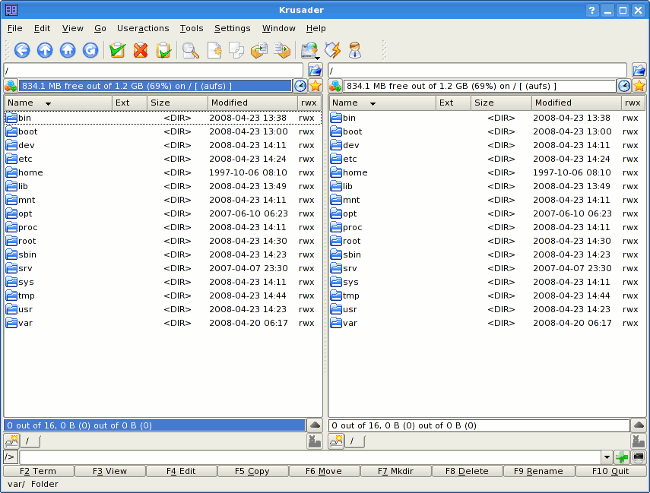
GNOME Commander
GNOME Commander is a “two-pane” graphical file manager for the GNOME desktop environment, it is built using the GTK+ toolkit and GnomeVFS.
The user interface is based on Norton Commander and you’ll find the same Key binding as default.
Stable release 1.2.8.15 Released on December 6, 2011
Features
- Gnome MIME types.
- FTP, SFTP and WebDAV support.
- SAMBA access.
- Right click mouse menu.
- User defined context menu.
- Quick device access buttons with automatic mounting and unmounting.
- Latest accessed folder history.
- Folder bookmarks.
- Plugin support.
- Python scripting.
- Fast file viewer for text and images.
- Meta data support for Exif, IPTC, ID3, Vorbis, FLAC, APE, PDF, OLE2 and ODF tags.
- Tools for advanced renaming of files, searching, quick file name search in current dir, symlinking, comparing directories.
- User defined keyboard shortcuts
- Integrated command line.
- Support for over 40 languages.
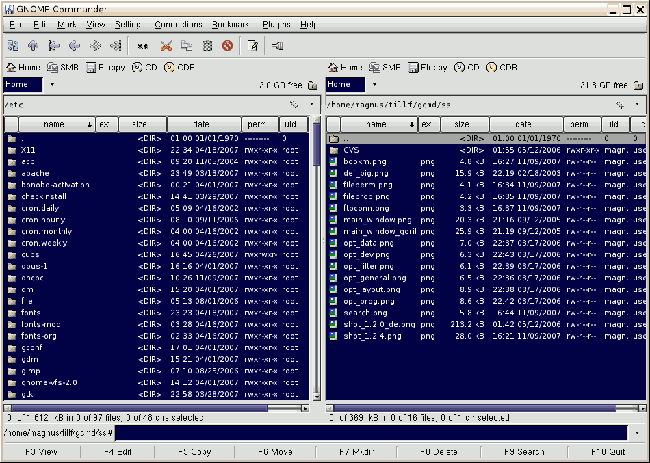
Midnight Commander
GNU Midnight Commander (also known as MC) is a free cross-platform orthodox file manager and a clone of Norton Commander. It was started by Miguel de Icaza in 1994.
This is my favorite software in this category, it works perfectly in a terminal and so is useful also on server without any Desktop Environment.
The main interface consists of two panels which display the file system. File selection is done using arrow keys, the insert key is used to select files and the Function Keys perform operations such as renaming, editing and copying files. Later versions of the Midnight Commander additionally have mouse support. Such versions are aware of GPM and X terminal emulators (such as GNOME Terminal or xterm) which support mouse reporting.
Features:
- Support for all basic file operations including move, copy, rename, delete, chown, link, view, and edit
- a built in Virtual File System that allows browsing of archives such as tar, compressed tar, RPM, deb, zip, cpio, lha, rar, and zoo files as well as remote files via FTP or the Midnight Commander’s own mcfs protocol
- Mouse support in xterms under X or at the Linux console via the gpm mouse server
- Built in text and hex viewer/editor as well as support for external viewer and editors
- Subshell support for the bash, tcsh, and zsh shells
- Built in Find File capacity
- Background copy or move operations
- Online help system
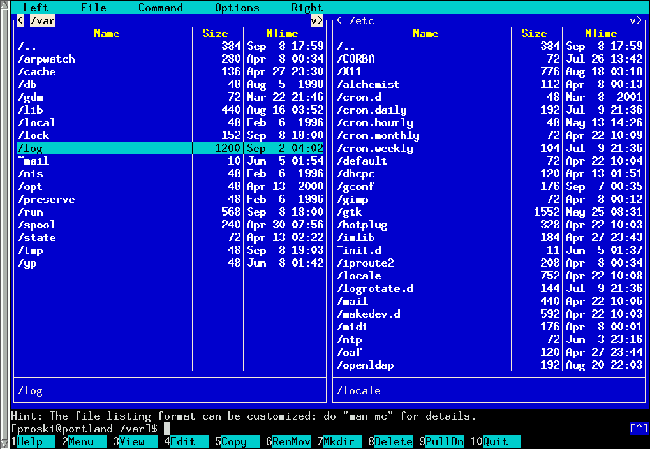
Vifm
Vifm is a ncurses based file manager with vi like keybindings. If you use vi, vifm gives you complete keyboard control over your files without having to learn a new set of commands.
Last Version vifm v0.7.2 released on February 19, 2012
As noted the main feature of this file manage is his key binding based on Vi commands so for example you can use these key bindings:
yy – Yank a file (or “copy” it).
p – Put a file (or “paste” it).
dd – Delete a file.
Enter – View a file.
t – tag the current file (you can do an action on multiple tagged files)
/ – Search for a file (the / character is followed by your search string).
gg – move to the top of the file list.
G – move to the bottom of the file list.
The Space Bar or Tab Key toggles between the two file lists.
So, you can move over a file “Yank” it with “yy” then use the space key or tab to move on the second panel, move around the filesystem and once you reach the destination paste it with the “p” key, easy if you are Vi addicted .
Ranger
So you like vi syntax but for some reason you don’t like vifm ?
No problem there is an alternative Twin-Panel file manage that use vi syntax: Ranger
Ranger provides a minimalistic and nice curses interface with a view on the directory hierarchy. The secondary task of ranger is to psychically guess which program you want to use for opening particular files, Ranger is developed in Python 2.6, Last version is 1.5.3 released on 2012/03/05.
Optionally you can install these programs to have a better preview/information on your files:
- img2txt (from caca-utils) for previewing images
- Highlight for syntax highlighting of code
- Atool for previews of archives
- lynx, w3m or elinks for previews of html pages
- Pdftotext for pdf previews
- transmission-show for viewing bit-torrent information
- mediainfo for viewing information about media files
- UTF-8 Support
- Preview of the selected file/directory
- Common file operations (create/chmod/copy/delete/…)
- VIM-like console and hotkeys
- Automatically determine file types and run them with correct programs
- Change the directory of your shell after exiting ranger
- Tabs, Bookmarks, Mouse support
Sunflower
This is the last software in this category it’s probably the most recent, but show good potentials.
Sunflower is a small and highly customizable twin-panel file manager for Linux with support for plugins. It is intended to be an easy-to-use and powerful file manager that seamlessly integrates into the GNOME desktop environment, currently this project is still in its early alpha stage.
Popular Posts:
- None Found


F3 in Nautilus also gives you a double panel.
I was told this trick by darkN00b1971 two years ago.
Life has been so much easier since then!
…as F3 in dolphin or konqueror for kde3 if i remember well.
Missing the best one – Double Commander http://doublecmd.sourceforge.net/
Yes. Double Commander v.0.6.1-beta is now my go to file manager on any Linux I install,
nowadays always with an Xfce4 desktop. DC is now comparable to the old Krusader
without all of the current KDE bloat.
You forgot 4Pane
You didn’t cover Worker, which is the fastest and one of the best twin panel FM.
You’ve allready forgotten one of the best: worker
Possible to configure more as you like with less dependencies
Greetings
XFE (X-File-Explorer) is the greatest, and very easy to compile from source – it uses Fox tk.
Back in the days of DOS, for file management and backup, I used PCTools (which eventually became Norton Commander) right through to Win98, NT4 & Win2000. After transitioning to Unix/Linux I used various tools, before discovering Unison for backups. I was quite happy with KDE’s file manager before Dolphin, and have always liked Nautilus in Gnome.
With the changes to KDE 4 and Gnome 3 I found some of the functionality I had got used to dissapeared so I started lokking around and discovered Krusader which does everything that the standard file managers do, plus synch and backup to external drives. I have a collection of USB externals and NAS boxes on my SoHO network and it works on all of them. I also use it to sync to my netbook and laptops and it works across distro’s. My main desktop is running Suse 12.1, KDE 4.7, the netbook is Ubuntu 10.04 Netbook Remix, and the laptops are both Ubuntu 11.10 with gnome Classic. On the Gnome desktops I use Gnome Commander which has almost identical features to Krusader, and on my one native WinXP install I use the newest version of Midnight Commander.
In order of preference I would rate Krusader 1st, for a very good interface and the range of features. The “Compare Directories” feature is particularly good, as I use it every day to run backups to NAS, and to sync work directories with my main laptop or a USB drive. Gnome Commander is nearly as good, and as is Midnight Commander. the only problem with MC is that it isn’t as good on Linux as Krusader or GC.
My experience is that whichever of these applications you use it needs to integrate well with your desktop, as the features are very similar between them.
muCommander? – http://www.mucommander.com
Why not just open 2 instances of your current file manager?
Usually this is not efficient as have an integrated Twin-panel manager, but it’s also true that everyone should the software/method he prefer.
spacefm
F3 in Dolphin in KDE desktop.
There is also an icon called Split view that either comes already on screen or that you can add with a click by right clicking Configure toobar.
Thanks for mentioning Sunflower. If people have any questions, please let me know. I would happy to answer! 🙂
check out tuxcmd http://tuxcmd.sourceforge.net/
Nice guide, always nice to see some fm’s i didn’t know before.
How did you manage to get the preview (flv) in the terminal in ranger ?